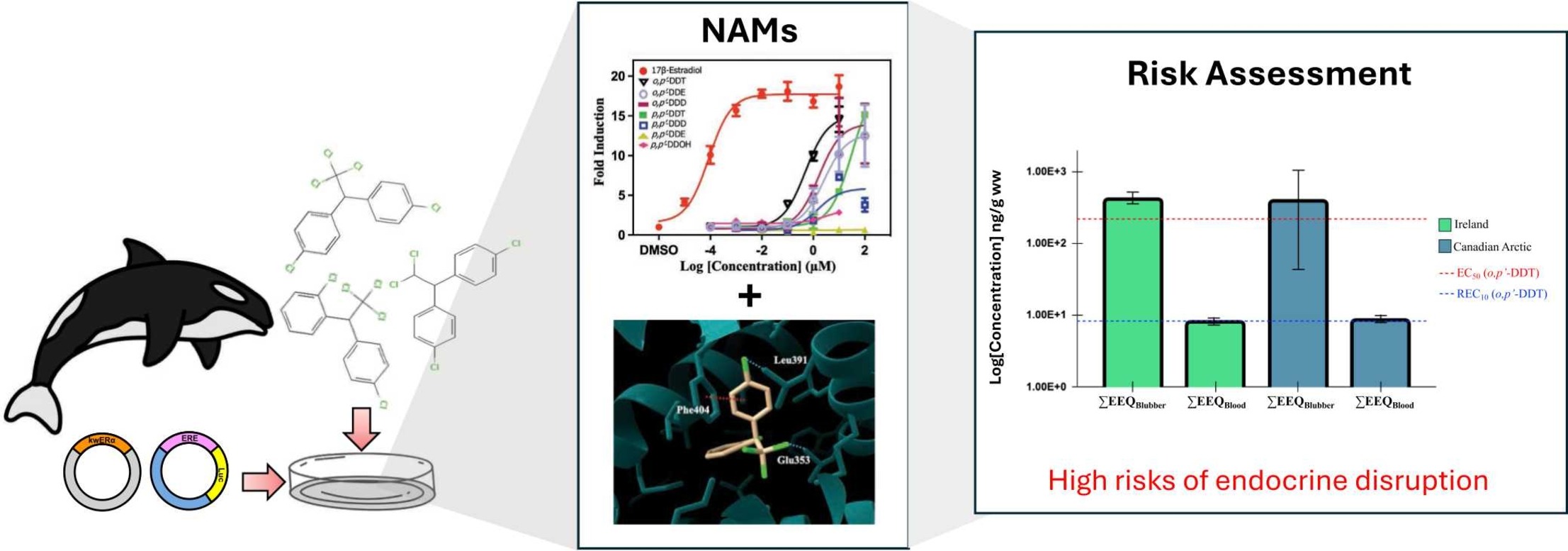Killer Whale Crisis: DDT Disrupts Hormones
Unseen Threat Compromises Future of Marine Apex Predator
Researchers at Ehime University successfully assessed the risk of DDTs on endocrine disruption in killer whales using New Approach Methodologies (NAMs) that avoid animal testing. By in vitro experiments and computer analysis, they found that DDTs activate killer whale estrogen receptor α, potentially disrupting hormone balance. This is concerning because DDTs levels in killer whales are high enough to cause harm. This study highlights the potential of NAMs for assessing chemical risks in wild species.
Killer whales, as apex predators with long lifespans, are prone to accumulating high levels of persistent organic pollutants (POPs) like DDTs in their bodies, raising concerns about the potential impacts. DDTs were widely used as insecticides, but are now banned in many countries due to their adverse effects on the environment and wildlife. However, DDTs persist in the environment and accumulate in organisms through the food chain, leading to particularly high concentrations in top predators like killer whales.
DDTs are known as endocrine disruptors, with potential adverse effects on reproduction and immunity. They can bind to a protein called estrogen receptor α (ERα), disrupting hormone balance and potentially causing reproductive and immune dysfunction.
Traditionally, chemical toxicity assessments have been conducted using laboratory animals like mice. However, experiments using large wild animals like killer whales raise ethical and technical challenges. Therefore, New Approach Methodologies (NAMs) have gained attention as alternatives to animal testing. NAMs aim to assess chemical toxicity without relying on animal experiments by utilizing in vitro experiments and computer simulations.
This study employed NAMs to evaluate the effects of DDTs on killer whale ERα (kwERα). Specifically, we established an experimental system using cultured cells expressing kwERα to examine whether DDTs activate kwERα. Additionally, we used molecular docking simulations to analyze how DDTs bind to kwERα on a computer.
The results revealed that DDTs activate kwERα, exhibiting estrogen-like effects. Notably, a DDT isomer called o,p’-DDT showed strong activation potential towards kwERα. Moreover, the potency of DDTs could be simulated using molecular docking simulations. Comparing DDTs concentrations in killer whales from Ireland and the Canadian Arctic with the concentrations that affected kwERα in vitro suggested that DDTs levels in killer whales could disrupt estrogenic activity.
This study demonstrated the feasibility of using NAMs to assess chemical toxicity and risk without conducting animal experiments on killer whales. Further research is expected to elucidate the detailed molecular mechanisms of ERα activation and apply these methods to other chemicals.
Reference URL: https://doi.org/10.1016/j.ecoenv.2025.117761
Bibliographic Information
Dave Arthur R. Robledo, Takahito Kumagawa, Mari Ochiai, Hisato Iwata,
New Approach Methodologies (NAMs) to assess killer whale (Orcinus orca) estrogen receptor alpha (ERα) transactivation potencies by DDTs and their risks,
Ecotoxicology and Environmental Safety, 291, 2025, 117761, ISSN 0147-6513,
https://doi.org/10.1016/j.ecoenv.2025.117761.
Fundings
- Grants-in-Aid for Scientific Research (S) [No. 26220103] and (A) [No. 19H01150 and 24H00753] from the Japan Society for the Promotion of Science (JSPS)
- The establishment of university fellowships towards the creation of science technology innovation, Grant Number JPMJFS2131 from the Japan Science and Technology Agency (JST)
- Joint Usage/Research Center – Leading Academia in Marine and Environment Pollution Research (LaMer) from the Ministry of Education, Culture, Sports, Science and Technology, Japan (MEXT)
Media
Contact Person
Name : Hisato Iwata
Phone : +81-89-927-8172
E-mail : iwata.hisato.mz@ehime-u.ac.jp
Affiliation : Center for Marine Environmental Studies, Ehime University


